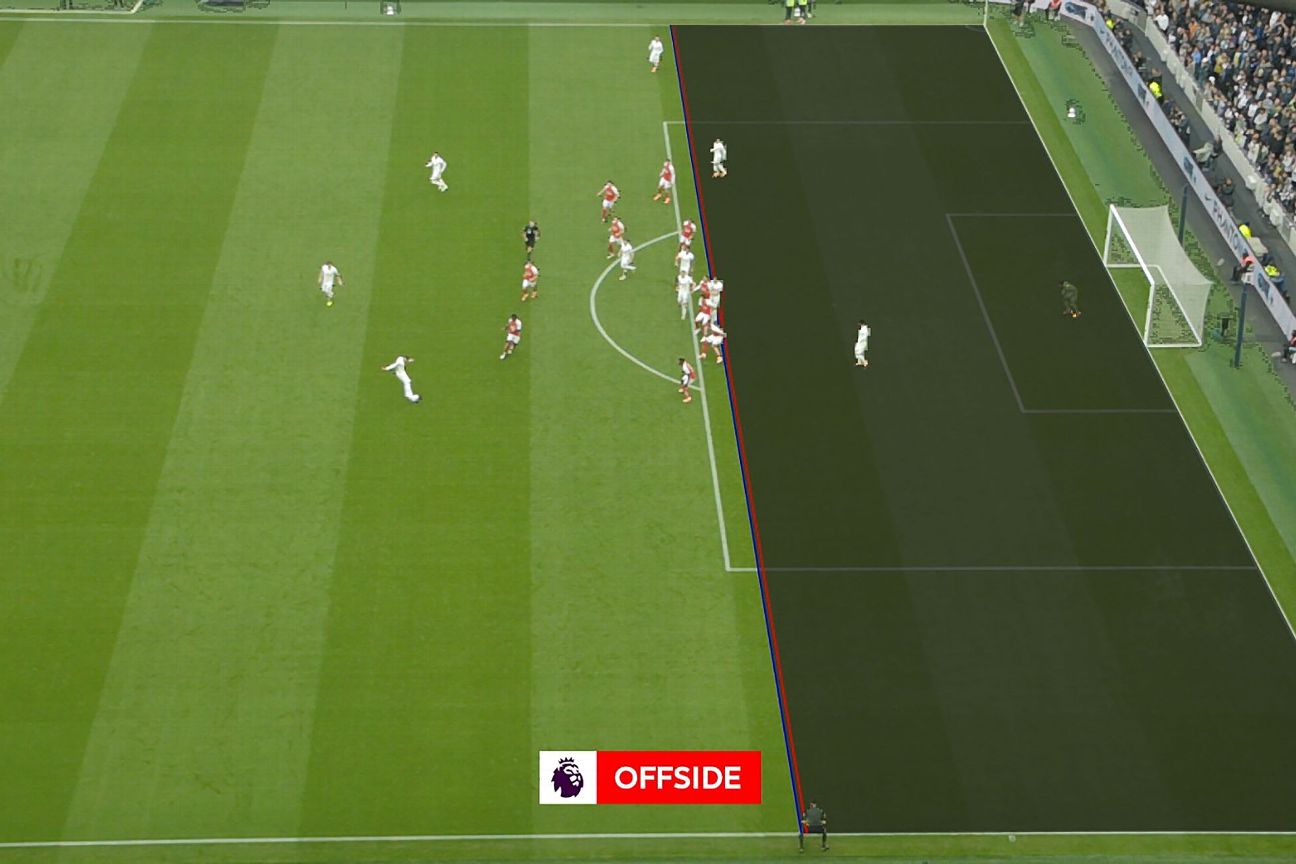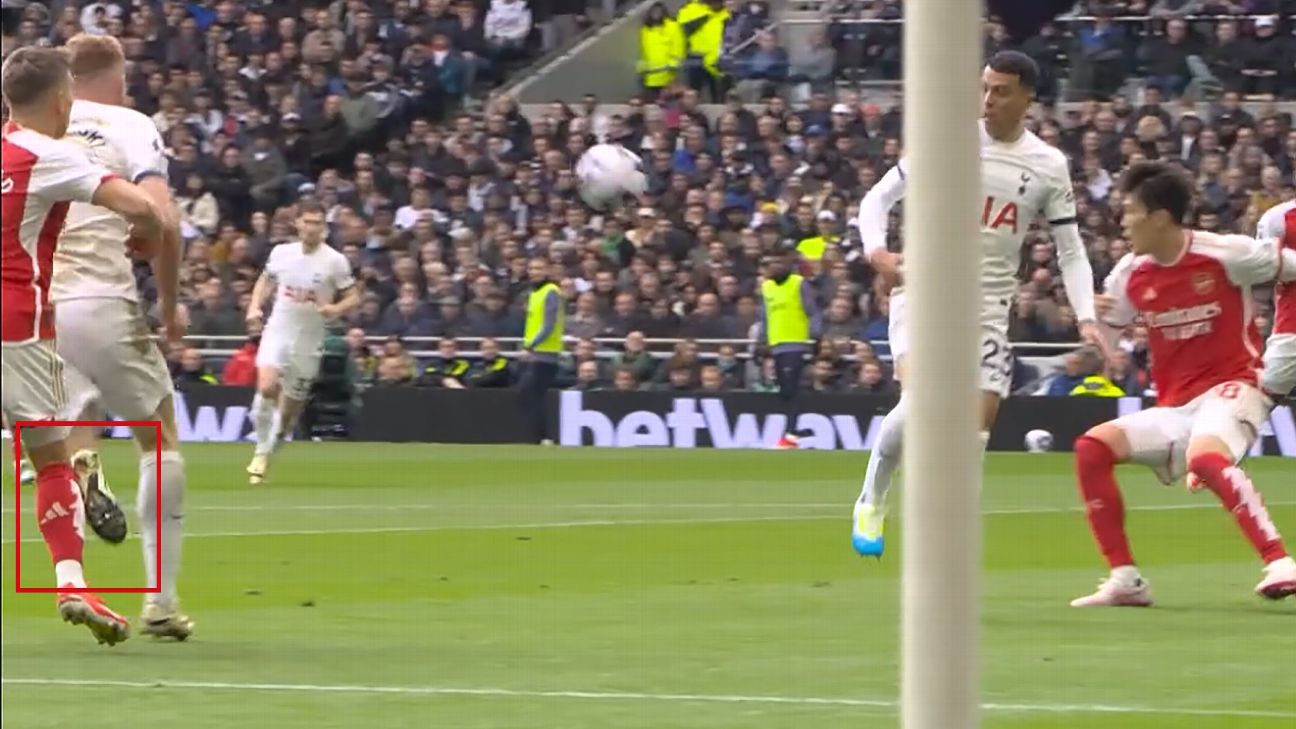Video Assistant Referee causes controversy every week in the Premier League, but how are decisions made, and are they correct?
After each weekend we take a look at the major incidents, to examine and explain the process both in terms of VAR protocol and the Laws of the Game.
– How VAR decisions have affected every Prem club in 2023-24
– VAR in the Premier League: Ultimate guide
In this week’s VAR Review: Should Tottenham Hotspur have been awarded a penalty before Arsenal broke to score their second goal? Was the VAR right to disallow Chelsea’s late winner at Aston Villa? And a look at the incident involving Cody Gakpo and Alphonse Areola.
Tottenham 2-3 Arsenal
Possible penalty and disallowed goal: Trossard challenge on Kulusevski
What happened: Tottenham Hotspur forward Dejan Kulusevski moved into the area in the 26th minute but stumbled to the ground. It was unclear if there was any contact on the Spurs player, and referee Michael Oliver allowed play to continue. Arsenal immediately launched a counter-attack, with Kai Havertz playing in Bukayo Saka to score. (watch here)
VAR decision: No penalty, goal stands.
VAR review: It was a pivotal passage of play, as if the VAR had chosen to get involved, then Arsenal’s second goal would have been ruled out and Tottenham had the chance to equalise from the penalty spot.
Yet while we’ve seen penalties awarded on the field for this, they haven’t been given through VAR.
Two specific examples spring to mind, perhaps most memorable being Craig Pawson’s decision to award a penalty to Wolves and send off Arsenal defender David Luiz when he had made inadvertent contact with the trailing leg of Willian José. The Gunners lost an appeal against Luiz’s red card for denying an obvious goal-scoring opportunity.
More along the lines of this incident was the spot kick awarded to Paul Pogba when his boot brushed the leg of Aston Villa’s Douglas Luiz, causing the Manchester United player to clip his own heels and go down in the area. The referee in that game just happened to be Oliver too.
Penalties can be awarded in this situation, as a defending player isn’t allowed to impede the movement of an attacker even if they haven’t made a challenge, otherwise it would give free rein to get close behind without attempting a tackle to stop their progress.
Though Kulusevski’s boot touches the leg of Trossard as he moves forward, it’s questionable whether this could ever be enough to be considered a clear and obvious error.
Possible offside: Van der Ven when scoring
What happened: Micky van de Ven thought he had equalised for Tottenham in the 22nd minute when firing home from close range — but there was a VAR check for offside. (watch here)
VAR decision: Goal disallowed.

VAR review: There are a few moving parts to this, though in VAR terms it was a clear decision with an obvious gap between the two lines for Van de Ven and the Arsenal defender, Gabriel.
The offside phase is set at the point Pedro Porro strikes the shot. Even though Takehiro Tomiyasu makes an attempted block, and the ball then comes off the head of Gabriel before it runs to Van de Ven, neither of these actions reset the phase to put the Tottenham player back onside.
The offside law requires a defender to make a “deliberate play” of the ball, yet this is about a player having the genuine expectation of a controlled outcome from their action. That doesn’t excuse a poor pass, but it does mean that an instinctive block of a shot hit with power cannot be considered a “deliberate play” — so Van de Ven remains active from the shot.
Possible penalty: Rice challenge on Davies
What happened: Ben Davies moved onto the ball in the 84th minute and went down after appearing to be kicked by Declan Rice. Referee Oliver immediately indicated there should be no penalty but very quickly the VAR, Jarred Gillett, sent him to the monitor for a penalty. (watch here)
VAR decision: Penalty, scored by Son Heung-Min.
VAR review: It’s a different incident to others we’ve seen in recent weeks, when there has been minimal contact on the boot of an attacker.
Rice is attempting to clear the ball, but isn’t fully aware that Davies is coming across. The ball comes off Daves’ left thigh, which takes the ball away from Rice who ends up kicking the Tottenham Hotspur player on his right thigh with the attempted clearance. Oliver must have believed there was little to no contact on Davies.
It’s only the second time Oliver has been sent to the pitchside monitor to change his decision this season — the other also coming at the same stadium to award a penalty to Chelsea and send off Spurs defender Chelsea
Possible disallowed goal: Challenge by Badiashile on Carlos
What happened: Chelsea thought they had scored a 95th-minute winner when Burnley
Possible penalty: Berge challenge on Garnacho
What happened: Everton defender.
Much like the decision not to intervene on the possible handball by Nottingham Forest last week, it shows how the VAR in the Premier League is only expected to get involved in the obvious handball offences when the arm is well away from the body or above the head.
It’s likely that like this kind of handball would be penalised in other leagues, especially LaLiga, but not in England with its more lenient approach.
Some parts of this article include information provided by the Premier League and PGMOL.



